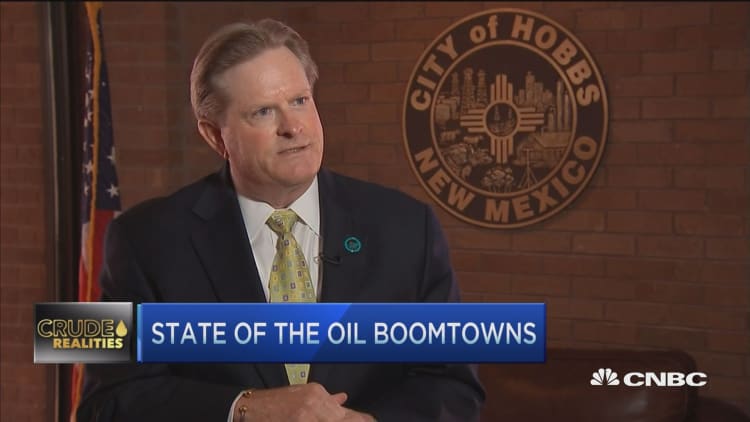
The drive west into Hobbs, New Mexico — a city of about 45,000 just over the line from Texas — takes you past the typical array of chain retailers and restaurants, as well as a row of newer hotels on State Highway 18. At first glance, it looks like any one of the countless similar pockets of development across the country. Except the hotels are largely empty, offering rooms at steep discounts. And traffic in general seems sparse despite all the new construction.
It wasn't always this way.
Hobbs is an oil town, anchoring New Mexico's portion of the Permian Basin — the nation's most prolific oil producing area, according to the Energy Department, made even more productive by new technologies like horizontal drilling and fracking. Two years ago, when crude prices topped $100 per barrel, the boom in Hobbs was something to behold.
"You couldn't get a hotel room, and if you could get one, they'd be $250 a night," said Mayor Sam Cobb.
The hotels along Highway 18 popped up as temporary housing for oil workers who were being bused in from around the country, but it wasn't enough.
"People were living in their cars," the mayor recalled.
Sales tax receipts for the city hit a high of $10 million a month at the end of 2014, around the time unemployment in Lea County hit a low of 3.5 percent.
For retailers like Richard Martin, owner of the Martin Boot Company store on Broadway downtown, there was a steady flow of customers with money to spend.
"The worst thing during the peak of the economy was that they didn't have time to spend it," Martin said.
Today, oil prices are down more than 60 percent, and Martin's customers have changed.
Now, he said, "They've got the time. They don't necessarily have the money."
Sales tax revenues for the city have returned to a more normal $3 million a month, and it is easy to see why. Heavy equipment like trucks and drilling rigs that would have been scattered across the countryside hard at work a couple years ago now sit idle in padlocked equipment yards.
Just outside of town in Manzano LLC's Bronco oil field, manager Mike Hanagan said the company stopped drilling new wells about a month ago because of the low prices. "You don't want to give your oil away at this rate," he said. That means less work for drilling contractors and oilfield service companies.
The county's unemployment rate hit 7.6 percent in February, according to the U.S. Bureau of Labor Statistics. The jobs that remain pay a fraction of what the oil workers had grown accustomed to.
"Normally, where a truck driver was making $100,000, now they're down making $40,000," said County Commissioner Gregg Fulfer, who was forced to lay off a handful of employees at his own small oil and gas company because of the downturn.
While all of this might seem to suggest despair, local officials say the situation spells opportunity. They say they learned from the last oil shock in the 1980s that booms don't last forever. So the city socked money away when oil prices were high.
"If you take that excess and put it in the bank and not spend it like you think you are going to have it forever, it does not create a huge issue," the mayor said.
In his office in City Hall — a building that previously housed a bank that went bust in the 1980s — Cobb displays architectural drawings for projects like a new wellness center that the city and county can afford to build now that construction is affordable again.
This is not to say that things have been easy in New Mexico, the nation's sixth-largest oil supplier, where oil and natural gas previously accounted for around 35 percent of state revenues. Earlier this year, Republican Gov. Susana Martinez and state legislators had to trim spending and dip into reserves in order to balance the state budget, and state forecasters are warning of more shortfalls next year.
State Economic Development Secretary Jon Barela says the situation should serve as a wake up call for New Mexico to diversify beyond its traditional economic drivers — oil and federal government spending.
"Any state, any political jurisdiction, can't put all of its eggs into one or two baskets as New Mexico has done for the last several decades," he said.
But out in the oil fields, they say don't count them out just yet.
Hanagan, a 30-year veteran of booms and busts, believes that because production was cut so quickly, prices are bound to snap back soon.
"I think we're going to see $60 this year, and I wouldn't be at all surprised to see $70 next year," he said.
It would be welcome news in Hobbs, even though residents insist they are ready for whatever comes their way.
Correction: This story was updated to correct County Commissoner Gregg Fulfer's last name.




